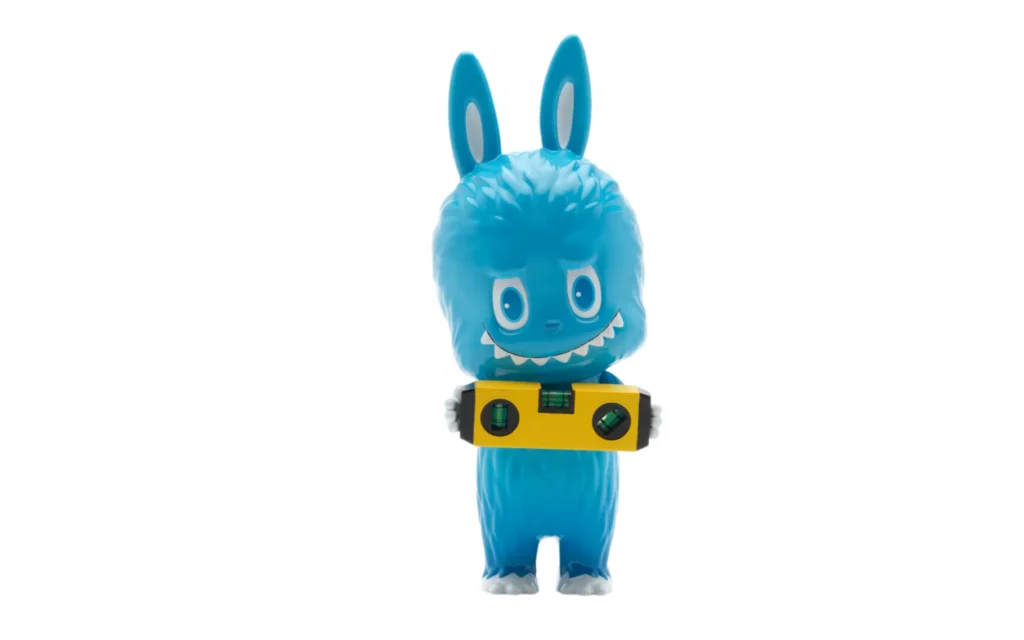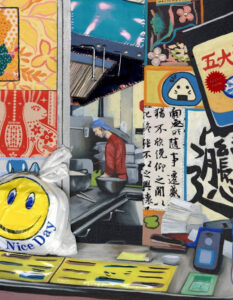PHOTO CREDIT: Courtesy of Art Basel
When an ornament becomes an icon, it shifts the boundaries of its cultural domain. At Art Basel 2025, Basel’s hallowed halls, better known for high-stakes galleries and avant-garde installations, briefly buzzed with the chatter over a small blue Labubu—a monster toy conceived by Hong Kong-born artist Kasing Lung. In a special collaboration with the fair’s curated shop, 100 porcelain Labubu dolls were produced, each sporting a mischievous grin and clutching a spirit level accessory. Priced at CHF 200 (approx. US$245), the dolls vanished from shelves within hours—half on general opening day (June 16) and the remainder during VIP access the following (June 17).
This seemingly minor event marked a fissure in the edifice of contemporary art norms, highlighting the convergence of designer-toy culture, social media virality, and collectible scarcity within one of the world’s most esteemed art markets.
Origins and Mythopoetics
Labubu first appeared in 2015 in “The Monsters,” a picture-book series by Kasing Lung shaped by Nordic folklore and the artist’s Hong Kong–Netherlands upbringingthetimes.co.uk+15thedailybeast.com+15timesofindia.indiatimes.com+15economictimes.indiatimes.com+2en.wikipedia.org+2people.com+2. Its fanged smile, pointed ears, and toothy allure straddle the line between mascots of childhood whimsy and artifacts of uncanny resonance.
The Pop Mart Nexus and Global Acceleration
In 2019, Lung partnered with Pop Mart, a Wuhan-based toy conglomerate renowned for blind-box collectibles. This alliance transformed Labubu into a global phenomenon. Typically sold for a modest ¥50 (US$7) in blind-box form, Labubus became a viral commodity, especially after celebrity endorsements by Blackpink’s Lisa, Rihanna, Kim Kardashian, and David Beckham scmp.com+15thesun.co.uk+15thedailybeast.com+15.
From $7 Plush to Six-Figure Sculpture
From affordable blind-box mysteries to life-sized art pieces, Labubu’s arc has been meteoric. In June 2025, the Beijing-based Yongle International Auction dedicated an entire event to Labubu collectibles, featuring 48 lots—including a unique 131 cm mint-green sculpture that sold for ¥1.08 million (~US$150,000)—and other pieces reaching up to ¥1.24 million (~US$172,000) scmp.com+14reuters.com+14popmartdaily.com+14. The auction’s white-glove clearance and record sums repositioned Labubu at the apex of designer-toy value hierarchies.
Aesthetics and Symbol: The Basel Doll Unveiled
Visual Details and Iconic Accessories
The Art Basel version of Labubu debuted in signature fair-blue porcelain. Designed with Lung’s signature cheeky expression, the figure incorporates a humorous nod to the art-world vernacular—a spirit level—held like an esoteric talisman referencing perfect gallery installations.
Materiality and Meaning
The shift from plush vinyl to porcelain is significant. Porcelain elevates Labubu, aligning it with the history of fine craft—Chinese porcelain legacies, European chinoiserie, and collectible art goods. The spirit level accessory bridges chance narrative (blind boxes) and precision (curation), amplifying commentary on the art ecosystem.
Market Mechanics and Momentum
Supply, Demand, and the VIP Sell-Out
Art Basel split distribution between general access and VIP privilege. Of 100 dolls:
-
~50 units sold on June 16 (public opening)
-
~50 units during VIP day, June 17
Lines formed early. Staff humorously intoned, “Is there anyone here who does not want a Labubu?”—and few raised their hands. Online resale ads appeared within hours—Chinese sites showing the dolls listed for €1,500 (~US$1,733)thesun.co.uk+15thedailybeast.com+15popmartdaily.com+15economictimes.indiatimes.com+5en.people.cn+5people.com+5businesstimes.com.sg+1tf1info.fr+1.
Fair Shop Controls
Art Basel authorities enforced two-unit limits per person, blocked online reservations, and mandated in-person pickup, attempting to curb automated resale activity. Yet listings emerged almost immediately, underscoring the volatility of collectible markets.
Flow
Gen‑Z and Bag-Charm Culture
Labubu’s rise fits the zeitgeist of ‘bag-charm aesthetics’. Smaller versions—often under 20 cm—now grace handbags and backpacks, symbolic accessories that traverse Instagram feeds and TikTok loops thedailybeast.com. Its blend of kawaii, uncanny, and flex-worthy status crystallizes a broader desire for trophy objects that are both whimsical and subversive.
Scarcity, Relic, and Remix
Labubu’s market trajectory evokes Beanie Babies, Furbies, and even Barbies turned art forms. But the porcelain Basel edition gestures beyond nostalgia. It presents a remix: designer toy meets architectonic precision.
Critic Liza Corsillo observed Labubu as “ugly, but huggable,” occupying a liminal space where endearment and distortion coincide thedailybeast.comen.wikipedia.org. At Basel, the nuance flips: precision (spirit level) in porcelain highlights institutional calibration amid playful irreverence.
Celebrity-Market Feedback Loop
Celebrity placements and auction records feed each other. Lisa’s endorsement triggered peaks of interest at blind-box releases; Beckham mentioning Labubu enhanced Western collector awareness. The porcelain Basel doll returned Labubu to elite art audiences. Though Art Basel declined to discuss future editions, the hype cycle continues—brace for upcoming collaborations.
Art Basel’s Strategic Shift
Hybrid Curation: Toys Amidst Paintings
For decades, Art Basel’s offerings mentally juxtaposed neo-expressionism with minimalist conceptualism. The inclusion of a porcelain toy in the Art Basel Shop signals an editorial shift: collectible designer objects stand alongside prints and monographs, reframing art heritage and design utility.
Scarcity Logic and Market Signals
With just 100 units, Basel’s Labubu doll exemplified controlled scarcity—a rarity that artificially inflates value. By releasing stock in stages and limiting purchases, Art Basel fine-tuned demand: a classic playbook in secondary market speculation.
From Literature to Market Essays
Miniature Objects as Literary Symbols
In literature, small objects can carry outsized symbolic weight—think Dickens’s pocket watch or Proust’s Madeleine. Here, Labubu functions similarly, embodying nostalgia, vanity, and identity. Its porcelain form mirrors metaphors in Woolf or Muriel Spark, where a pebble or bauble under glass evokes entire worlds.
The Spirit Level as a Motif
The spirit level suggests equilibrium, a mythic axis balancing public and private art, whimsy and seriousness. It’s also a jocular jab at the art market’s fetish for installation perfection—blurring folly and gravity.
Future Outlook: What Comes Next
Secondary Market Dynamics
Listings at ~€1,500 are only initial waves. Should an auction record hit Basel (e.g., life-sized porcelain), speculation will buoy value. The unclear stock policy hints at a volatile aftermarket.
Institutional Precedents
Expect follow-up blasts: Basel could replicate the Labubu model. Other fairs (like Frieze or FIAC) may launch their own pop collectibles, spawning fair-specific toy ecosystems.
Transparency and Ethics
Future iterations require clarity: disclosure of edition counts, authentication mechanisms, buyer fairness. Without transparency, market backlash or counterfeiting—already noted in UK queue hassles—may harm brand equity.
Tiny Titan, Big Statements
Art Basel’s porcelain Labubu neither commanded the exhibition floor nor rattled auction halls. Yet its cultural resonance is undeniable. Within 100 porcelain frames, it carried Nordic myth, Hong Kong origin, viral celebrity, Swiss curation, and Chinese scarcity into a compact form.
The Art Basel Labubu—fanged, blue, spirit-leveled—stands as a capsule of 2025’s cultural state. It affirms that art’s gravitas no longer lies solely in size or medium, but in intersectionality: a vinyl plush can become porcelain art, a spirit level can be curatorial critique, and a toy can break the bank.
No comments yet.








